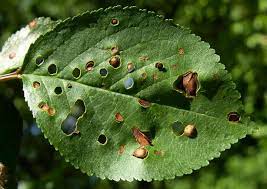24/7 Emergency Service
24/7 Emergency Service

Trees are a valued addition to any landscape and offer many benefits that improve the quality of life. Like most living things, the trees in your backyard require regular care and maintenance for good health and growth. Since many signs of infection and infestation go undetected until it is too late, hiring a professional tree service helps. Southern Star Tree is a reputable tree care company with extensive industry knowledge and experience dealing with common tree problems like shot hole fungus.
Also known as Coryneum blight, the disease is prevalent in fruit trees, such as nectarine, peach, plum, and apricot. While it is not common, shot hole fungus can also affect prunes, almonds, and ornamental trees. DIY control techniques are usually futile when dealing with shot hole disease, and a tree service should be contacted once the trees have been infected. The best way to treat this nasty fungus is through prevention, which requires detecting signs of deterioration early.
Like most fungi, shot hole disease thrives in damp conditions, and it is more common during prolonged wet periods. The best time to inspect your trees is during spring because the fungus is attracted to new growth. Shot hole fungus hides in infected twig lesions and buds throughout winter, ensuring the spores survive the harsh weather. We can inspect the entire tree for signs of damage and recommend the most effective preventative measure.
If you detect spots on lesions, young leaves and shoots, and new buds in spring, call a tree care company in Alpharetta for professional help. The spots become more prominent with time, causing the foliage to turn brown and fall out. The fungus adds stress to trees, affecting their ability to produce fruits. Any fruit that develops is likely affected, with spotting on the surface, which becomes rough.
Shot hole disease infects trees between fall and spring, but the most damage is when the following winter. If spring rains extend, they can encourage the spread of infection as spores are spread through splashing rainwater. Avoid overhead watering, which may contribute to spreading the infection, mainly if the infection hasn’t spread to surrounding healthy trees.
The key to mitigating the spread of infection is maintaining good sanitation, which goes a long way in keeping the disease at bay. Infected blossoms, buds, twigs, and fruits must be destroyed immediately. Remove contaminated leaves beneath and around the tree to prevent a recurrence.
While many fungicides and chemicals are on the market for treating shot-hole fungus, it is advisable to consult a tree service. Some products may not be suited for the type of trees in your backyard, destroying the tree in the process. Our professional arborists can assess and recommend a suitable treatment solution without compromising your trees’ health and overall well-being.
Contact us at Southern Star Tree and learn more about protecting your trees from common enemies. Please schedule a consultation with our representatives to enjoy top-notch tree care and maintenance at competitive market rates.
17 May, 2024
Summer is usually hot, which can take a toll on your yard. While many trees maintain green canopies, some species shed their bark. If you notice this natural occurrence, consult a tree service expert to ...
Read More11 May, 2024
Tree pruning is an essential practice for maintaining health, aesthetics, and functionality. When done correctly, pruning can promote growth, improve structure, and prevent disease...
Read More